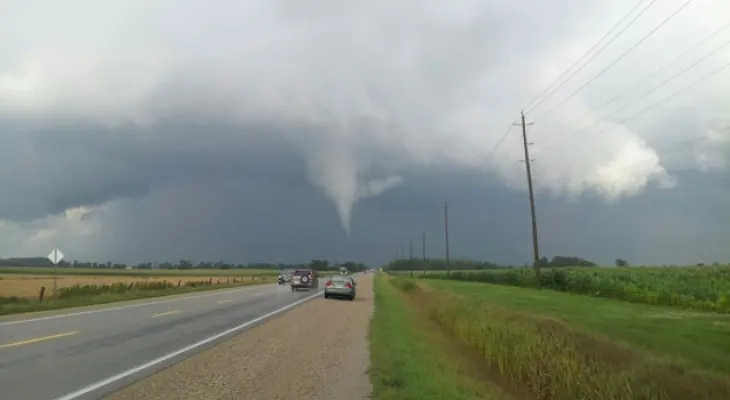Search here
Newspaper
Search here

Arab Canada News
News

Published: June 23, 2024
Ontario has overtaken the Prairie Province, which was previously thought to be the tornado capital of Canada, according to new data analysis conducted by tornado researchers at Western University.
David Sills, the executive director of the Northern Tornadoes Project (NPT), launched in 2017 to collect data on tornado incidents, said that previous statistical analysis showed that southern Saskatchewan should be "the focal point of tornado activity in Canada."
Sills told CP24.com on Wednesday, "Since we started the project, the number of tornadoes in Saskatchewan has not been nearly what we thought it would be."
Sills added that researchers are looking at tornado climates over a span of 30 years. Between 1980 and 2009, Saskatchewan ranked first in Canada with an average of 17.4 tornadoes annually.
Sills said, "We just did an updated version, which is a new 30-year period from 1991 to 2020, and here Ontario comes out on top with 18.3 tornadoes annually."
"We found in Ontario and Quebec that there is a significant amount of activity since we started the project. This was somewhat surprising because of the tornado activity that occurs in Eastern Canada.
Sills noted that since the launch of the Nuclear Non-Proliferation Treaty, over 700 tornadoes have been documented across Canada.
"Initially, we just wanted to see if we could find some of the missing tornadoes that we thought occurred in Northern Ontario or Northern Quebec in the forests where we don't get a lot of reports."
Not a good trend
Sills stated that tornadoes appear to be happening a little less in traditional "tornado alley" areas, a pattern that has been documented in the United States.
He added, "More tornadoes are happening in the eastern part of the country, which is also the most populated part of the country, and so that's not a good trend."
"We have a lot going on regarding climate change, drought, and wildfires. All of these are factors that influence where tornadoes will develop.
Sills mentioned that the project helps researchers get a better picture of where tornadoes are actually occurring in the country.
"Before the project started, the average number of tornadoes documented in Canada annually was around 60 tornadoes. Now the number has risen to about 100. So, we have already increased the number of tornadoes we capture each year through this project. And this is the type of change in our climate science."
He continued, "We are trying to get closer to reality, right? What is actually happening that we didn't know before. We mostly knew what was happening in populated areas, not across the country. So now we have a better idea."
Jess Smith, a weather specialist at CTV, explained that tornado components include warm, moist air near the ground, cold, dry air aloft in the atmosphere, wind shear, and variations in wind speed and direction.
She told CP24.com, "With more heat waves occurring earlier in the summer season and warmer summers overall, it's reasonable to expect more thunderstorms that can produce tornadoes and tornado activity."
She added, "It has been so successful that by 2019, we began to document all tornadoes across Canada. Essentially, anything that was discovered, whether it was a tornado or just wind damage, we would investigate it and include it as part of our dataset to document that event."
Community awareness is needed
Sills emphasized that the goal of the NTP program is not only to collect data on tornadoes but also to mitigate any damage to people and property.
"If tornadoes start moving into more populated areas, we definitely need to start thinking about making communities more resilient, and we are working on that... Things like using tornado ties to ensure the roof stays on a house if you have, for example, an EF-2 tornado.
"If we can keep the roof intact during those tornadoes, then we've solved most of the problem regarding keeping homes intact and not losing people's belongings when the roof is blown off."
He noted that areas with more "community awareness" of tornadoes are typically cities and towns that have experienced significant tornadoes in the past, including Barrie, which saw an EF-4 tornado in 1985.
He said, "This is a community that really knows about tornadoes and has this kind of community awareness of tornadoes, perhaps better than other communities that haven't been hit by a tornado."
"Overall, I think people are not aware that all the things they see on television screens about tornadoes causing all this destruction can happen here, especially from June to August in Canada. We can definitely get those significant tornadoes. They happen less frequently here."
He urged people to pay attention to warnings and watches from Environment Canada and to sign up for mobile alerts issued by the national weather service.
He added, "It's something that saves lives."
Sills stated that Ontario has already seen a busy start to the tornado season, "We still have July and August, and even September ahead of us."
Comments